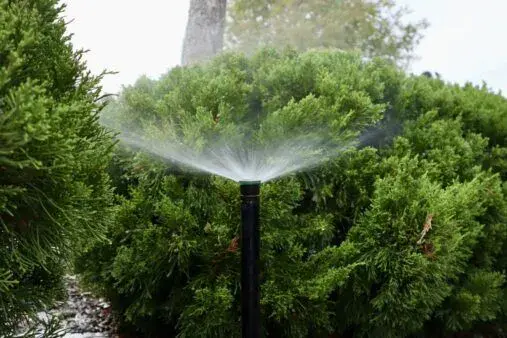Texas summers can be relentless. High heat, strong sun, and inconsistent rainfall all take a toll on lawns. That’s why irrigation matters so much here—and why getting it wrong can do more harm than good. Whether you’re trying to keep a lush lawn or simply prevent it from turning brown, knowing what not to do with your irrigation system can save you time, water, and money.
Here are some of the most common irrigation mistakes Texas homeowners make during the summer months—and what to do instead.
Watering at the Wrong Time of Day
Watering your lawn during the hottest part of the day might seem helpful, but it’s actually one of the worst times to do it. Midday heat causes most of the water to evaporate before it reaches the roots. In Texas, where summer temperatures can easily soar above 100°F, this means wasted water and dry grass.
Better approach: Water your lawn early in the morning, ideally between 4 AM and 8 AM. This allows the water to soak into the soil before the sun gets too strong. Evening watering might seem okay too, but it can leave grass damp overnight, increasing the risk of fungal diseases.
Overwatering
It’s easy to assume that more water equals a healthier lawn, especially during a drought or heat wave. But overwatering can be just as damaging as underwatering. It can lead to shallow root systems, increased weed growth, and even lawn fungus. According to Texas A&M AgriLife Extension, most lawns only need about 1 inch of water per week, including rainfall.
How to avoid it: Use a rain gauge or a small can to measure how much water your sprinkler system puts out. Water deeply and less frequently to encourage deep root growth, which makes your lawn more drought-resistant.
Uneven Coverage
Many sprinkler systems don’t distribute water evenly. Some areas may be soaked while others stay dry. This results in patchy grass and inconsistent growth. Uneven coverage often happens when sprinkler heads are blocked, clogged, tilted, or broken.
Tip: Check your system while it’s running. Watch for areas that aren’t getting water and look for signs of poor performance like low spray or misting. Adjust or replace heads as needed.
Wrong Irrigation Schedule
Setting your irrigation system on a fixed schedule without adjusting for weather conditions is a mistake. Watering when it’s recently rained or during high humidity days wastes water and may cause lawn stress. Texas weather is anything but predictable, and your irrigation system needs to account for that.
Smart solution: Use a weather-based smart irrigation controller that adjusts watering based on rainfall, temperature, and humidity. Some cities in Texas even offer rebates for homeowners who install these systems.
Watering Too Frequently
Frequent, light watering encourages grass roots to stay near the surface, making your lawn more vulnerable to drought. This is especially risky during Texas heatwaves.
Instead, Aim for deep watering that penetrates at least 6 inches into the soil. You can check this by pushing a screwdriver into the ground after watering. If it slides in easily, you’re watering enough.
Ignoring Soil Type
Texas has a wide range of soil types, from dense clay to sandy loam. Each one absorbs and holds water differently. If you don’t adjust your watering to match your soil, you could either be drowning your grass or starving it.
Quick guide:
- Clay soils retain water but absorb it slowly. Water in short bursts to prevent runoff.
- Sandy soils drain quickly. You may need to water more often, but for shorter durations.
Not Adjusting for Lawn Slope
Lawns on a slope are more prone to runoff. Water tends to flow downhill before it has time to soak in, especially if it’s applied too quickly.
Solution: Try cycle-and-soak watering. Run your system for a short period, let it rest for 30 minutes, then run it again. This allows water to seep in gradually instead of running off.
Poor Sprinkler Placement
When sprinklers are too far apart or too close together, water distribution suffers. Sprinklers should overlap slightly to ensure even coverage.
Best practice: Follow the “head-to-head” rule, where each sprinkler’s spray reaches the next one. Also, make sure sprinkler heads are clear of tall grass or obstructions.
Not Maintaining the System
Even the best irrigation system won’t last forever without regular upkeep. Cracked pipes, clogged nozzles, broken heads, or a misaligned controller can all reduce performance and waste water.
What to do: Inspect your system monthly during the growing season. Look for puddles, dry spots, or hissing sounds that could indicate leaks.
Forgetting Seasonal Adjustments
As the seasons shift, so should your irrigation. Many Texas homeowners forget to adjust their watering schedule as summer fades into fall, resulting in overwatering during cooler months.
Helpful habit: Adjust your system monthly or use a seasonal adjustment feature if your controller has one.
Not Following Local Water Restrictions
Many Texas cities have watering restrictions during the summer to manage drought conditions. Ignoring these can lead to fines and wasted water.
Do this: Check with your city for current watering rules. Many have designated days and times when watering is allowed.
Texas summers don’t leave much room for irrigation mistakes. Knowing when, where, and how much to water is key to maintaining a healthy lawn. Even small changes can improve your lawn’s appearance, save water, and reduce stress on your system.
By avoiding the most common mistakes listed here, you give your lawn its best shot at staying green and strong through another hot Texas summer.
Also Read-Learn the Collective noun for Wildlife
